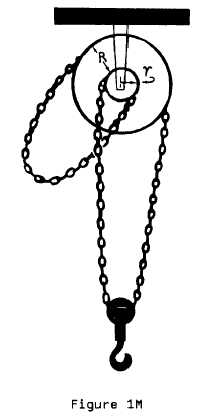1–41.
With a block and tackle the effort
has to move 125 feet in order to
raise a load 25 feet.
The friction
is so great that it takes a force
of 75 pounds to lift a load of 300
pounds.
The actual mechanical
advantage is
1.
five
2.
two
3.
three
4.
four
1-42.
The theoretical mechanical
advantage of a differential pulley,
such as the one pictured in figure
1M, depends upon the
1.
difference in diameters of the
t w o
t o p
p u l l e ys
2.
sum of diameters of the two top
pulleys
3.
length of the chain
4.
difference in diameters of the
two small pulleys
1-43.
In the differential pulley pictured
in figure 1M, if the radius of the
small pulley at the top is 3
inches, the radius of the large
pulley at the top is 4 inches, and
the radius of the pulley at the
bottom is 2 1/2 inches, the
theoretical mechanical advantage is
1.
8
2.
9
3.
30
4.
36
1-44.
Why is the actual mechanical
advantage of the differential
pulley of textbook figure 2–11
never so great as the theoretical
mechanical advantage of the pulley?
1.
Part of the effort applied to
the chain is used to overcome
the frictional resistance of
the pulley’s moving parts
2.
The diameter of C is between
those of A and B
3.
The diameter of A is greater
than that of B
4.
The length of the chain fed
down is greater than the length
of the chain fed up
1-45.
A wheel and axle can rotate
clockwise or counterclockwise about
an axis to provide a mechanical
advantage or an increase in speed.
1.
True
2.
False
1-46.
The mechanical advantage of a wheel
and axle depends upon the
1.
amount of force applied and the
size of the wheel
2.
size of the wheel and the
amount of the resistance
3.
ratio of the radius of the
wheel to which force is applied
to the radius of the axle on
which it turns
4.
length of the axle
7

